Google Nexus 5 Review
The Google Nexus One was strictly a developer device, with promises of instant updates and stock Android experience. It did not retail at prices that undercut the competition($530) but managed to become the only device that had the latest Android version. The Nexus S was similar, but with Galaxy Nexus, Google managed to price it surprisingly lower than the competition with similar hardware, thanks to introduction of the Google Play ecosystem. Somehow, from being a costly developer device, the Nexus became a highly desirable and affordable device, that brought users the best Google experience.
Video Review
Buy the Nexus and you will not only get the latest Android update instantly, but also get the best Google experience out of the box. That was Google’s message for the consumers. Right from the design, the material choices and the software experience, it’s pure Google. Two generations ahead, it is now more pronounced than ever, with the Google Nexus 5. LG was the company that Google chose, to make theNexus 4, which was a runaway hit, to say the least. It remains the same this generation, except for better availability of stock at launch, and seemingly, a better device overall, improving upon its predecessor with a better display, a faster processor and.. Lets say it’s just keeping up with the times. So, is the Nexus 5 the best Google device ever made? If you already have a Nexus 4, should you upgrade? We answer these questions and some more in our full review of the Google Nexus 5, read on.
Box contents
We had unboxed the Nexus 5 some time back and found it to be pretty bare, like all the earlier Nexus boxes. As expected, there was no headset in the box, but surprisingly we found that LG has bundled its own in-ear headset inside the Indian retail package. May be this is why they charge us extra money. Anyways, here are the box contents -
Here is a quick unboxing of the Indian retail version.
Design, Build and Ergonomics
The design of the Google Nexus 5 is quite different from its predecessor, but much like the Nexus 4, it is definitely not awe-inspiring. Apart from the usual flat face, curvy corner design, much of the Nexus 5′s design is attributed to its colours. We have the white Google Nexus 5 which comes with a nice dual tone setup on the back as well as the front with distinctly visible contrasts. The camera unit on the white back is black and ear piece on the black front is white.
Interesting design decision from Google here, because the ear piece sort of kills the stealth black look associated with the front, which looks so slick in the black version. The device is not unibody, which is quite evident from the sandwich arrangement in the white version, while the black variant looks more cohesive.
Talking of the body, the Nexus 5 is predominantly plastic. Again, with the colour variants we have differences in build quality and materials used, but lets talk about the white version first. The front is a full sheet of glass and the back is made of smooth matte plastic. The sides are made of glossy plastic, which is a fingerprint and grease magnet that totally kills the otherwise premium look of this device.
The white back looked excellent at first, with a beautiful smooth texture which rendered it slippery, but over the course of time, the back not only became dirtier, but also began showing gloss on its curved sides. Yes, it does attract grease over the long term and this shine and gloss added to the back thankfully at least adds a little bit of grip. Coming back to the sides, the glossy plastic here is downright cheap.
It even had some weird dents on our device, although we had or have never dropped it once. But again, these issues are all non existent with the Black variant. Want to know all the exact differences, advantages and disadvantages of choosing either colour? You need to read the feature that we did earlier, it might answer that all important question of which colour to choose.
The Nexus 5 might not look inspiring, nor it might be built very well, but it makes up for it in comfort. It is easily on of the most comfortable devices we have used. Weighing in at just 130g, the device is deceptively light, even though the numbers don’t say so. With a 16:9 form factor, the device is narrow and long, with thin bezels making it narrower than the usual. It kinda looks like the Oppo Find 5. The top and bottom have been given a nicely curved arc, which along with the curved corners provides a blunt and comfortable placement in the hands.
It is also just 8.59mm thick, contributing to better overall ergonomics. Overall, like we said earlier, the device might not look amazing or is built with the best materials around, but it does prove to be one of the most comfortable devices we have used. Now lets see what the overall hardware is like.
Hardware Walkthrough
The Google Nexus 5 has a full sheet of Gorilla Glass 3 on the front. The glass is extremely smooth to touch, indicating some form of oleophobic coating applied here, as it does resist fingerprints to some extent. Underneath the glass you have the 4.95″ display.
There is a cut out for the circular grilled ear piece, which is white in the white variant and black in the other. To its left lies the 1.3 MP front facing camera and to the extreme right lies the sensor duo.
We don’t have capacitive shortcuts at the bottom, but there exists a notification LED right in the middle of the bottom bezel. This placement is very similar to what we have on the Nexus 4.
The right side of the phone houses the power/lock switch, made of the sturdy ceramic material. It is solid, but quite sharp when run over with your fingers. Right below the power/lock switch Is the micro SIM tray. Using anything other than the in-box tool to eject this slot will lead to slight damage to the small pin hole.
Over at the top we have a 3.5mm audio jack and the secondary microphone, which will eventually help in omnidirectional stereo audio in video recording.
The left side houses the single piece volume rocker, which is also made of the same ceramic material. While the buttons are fine, the placement is not exactly optimal for this long and narrow form factor.
Over at the bottom we have the micro USB slot with SlimPort support(just another MHL video out competitor) and a mono loud speaker with an extra fake speaker grille. We also think the primary microphone might be hiding underneath that fake grille that sits to the right of the USB.
Turning over to the back we have the 8 megapixel camera with OIS sitting in a shiny black circle, along with a single LED flash and the Nexus and LG logos. The Nexus logo is shiny/glossy and is placed similarly to the one on the Nexus 7 2013.
One small thing we noted was that the tiny gap between the glass sheet and the plastic frame collected dust sometimes. It’s impossible to avoid dust here, so it’s a legitimate concern in the long term. Lets now move on to the finer details of marquee hardware.
Display
The Nexus 5 comes with a 4.95″ Full HD IPS LCD display, with a pixel density of 445 PPI. The panel, made by LG, is actually really good. At a normal head on viewing angle, the display is vibrant, bright, colourful and fantastic for all kinds of usage. The wallpapers pop out and the blacks look deep, indicating some really good contrasts on this screen. The colours are a bit washed out when compared to other full HD screens and like any LCD panel, the viewing angles are a hit and miss, with evidences of poor quality control in terms of light bleeding.
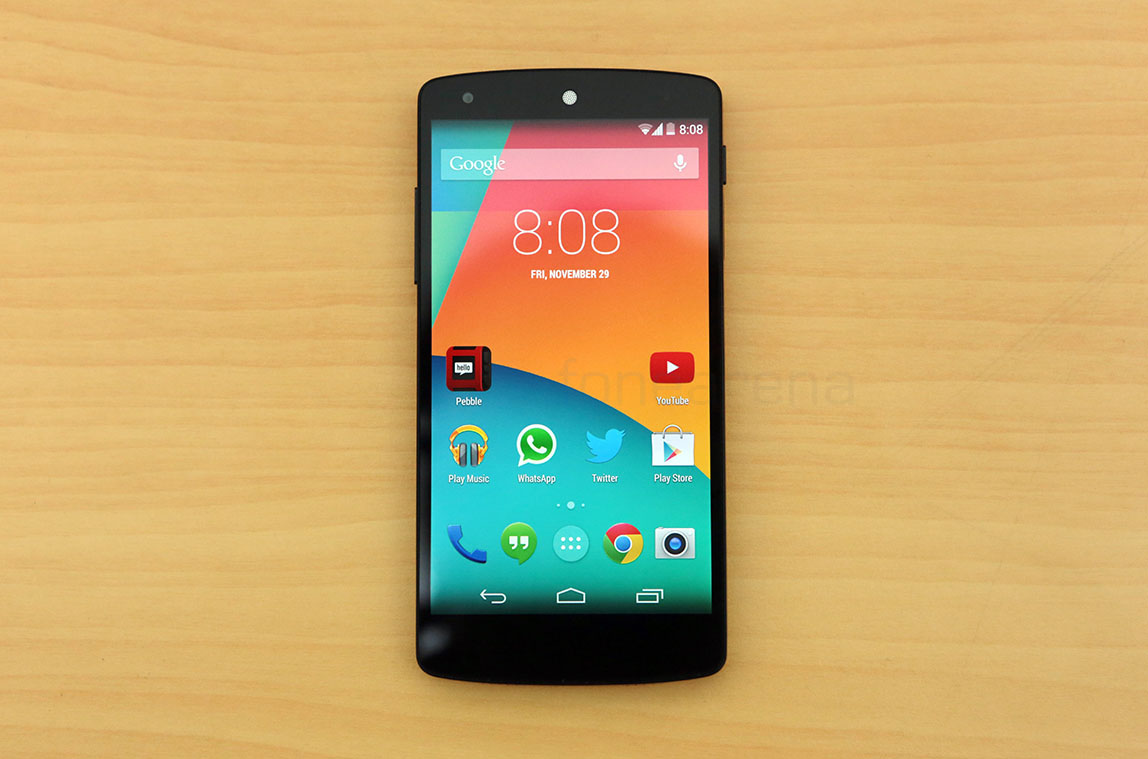
The 1920×1080, a 16:9 upgrade from the Nexus 4′s 15:9 1280×768, is great for a crisp reproduction of whatever content you consume on the screen, be it text, images, or videos, it just looks great. The outdoor visibility too, is typically good, but it is no match for AMOLED displays, generally in all the aspects. It is evident that Google and LG have looked to cut some corners with this display to bring down the cost, and it shows. However, it’s not bad at all. In fact, standalone, it’s a really good display, but it’s unfortunately no match for the other full HD screens of flagship devices like the LG G2 and the Samsung Galaxy Note 3.
Our inference is based on a full HD display comparison test we did with the aforementioned devices. Take a look and find out how the Nexus 5′s display compares to other heavy weights that are proper flagship devices.
Overall, we personally believe that it is a pretty great display standalone, but certainly not the best we have seen, nor is competitive with the other full HD displays.
Camera
The Nexus, right from the first one has been jinxed with very poor cameras in each iteration. While it seemingly got better with each upgrade, the results never delivered expectations. The Nexus 4′s camera sucked so much that it soon became a running joke that Nexus = poor camera. Have Google finally changed that with the Nexus 5? We are inclined to say yes. But before explaining why, here is the video of a complete overview of all the camera functions, the photos and the video performance of the Nexus 5 -
The Nexus 5 has a 8 Megapixel camera unit on its back, and is the first Nexus device to feature optical image stabilization. This is a slight downgrade from the 13 MP Exmor RS unit on the G2, but we are guessing it’s the 1/4″ type sensor of the same range implemented here. The aperture of the lens is rated approximately at f2.6 because it tends to change with two different modes, although we can confirm that this is no variable aperture. The sensor is capable of recording full HD videos too, but it lacks the 60 fps option the G2 has, even though both are based on the same chipset.
Lets take a look at the camera samples now. Click on the thumbnail to open in full resolution.
Daylight
Most of the pictures here are taken in HDR+ mode, which we will explain, as to what it does, below. The details of all the daylight pictures have come out rather well considering that the sensor is tiny. We notice that there is slightly warmer tint to all the photos, signalling a iPhone-like post processing approach, with sharp and fine details. Impressive results overall. It is highly recommended that you use the HDR+ mode. However, the only caveat with the camera app we found is that it is too slow. Taking a photo and seeing it slowly appear in the gallery is not-instant, which is highly preferred for mobile photography. Anyways, moving on.
Macro
With high aperture and a tiny sensor, the depth of field is wide and deep, so no bokeh here. Also, it was very hard to focus on objects at a close macro range. It almost always never focused and constantly hunts for focus even after locking. Saddled by the poor autofocus performance, the only redeeming fact is the quality, which is pretty good on these photos.
Low Light
The Nexus 4 was understandably poor in low light, but thanks to the HDR+ mode here, even though if the phone can’t lock focus all the time, the low light photos actually turned out pretty decent. Normal mode is a no-go but we think HDR+ is the perfect solution for the Nexus 5 to take decent photos in any condition.

As you saw from the camera samples and demo in the video, there is something mysterious with the Nexus 5′s camera. This particular HDR+ mode on the camera UI actually triggers a quick reboot of the viewfinder when switching between the normal and HDR+ modes, which then completely changes the approach to a scene. This got us intrigued, as we couldn’t see any trace of a higher dynamic range capture with the “HDR+” indicating so. Terrible misnomer, we feel. It’s actually much more than that, but it’s not easy to explain without examples, so you can go ahead and check this feature out – Demystifying Google Nexus 5′s HDR+ mode. TLDR; It’s no HDR, but it definitely takes great pictures, even if it impacts the overall performance of the camera.
Video performance on the other hand, is pretty good. We see the same warmer colour tones here, but the OIS unit works surprisingly well to eliminate shake that is persistently seen in videos. The mics also do a great job in alienating the noise and providing a nice omnidirectional stereo output in the result. Here’s a video sample in case you missed it out on the camera review -
So that concludes our analysis of the Google Nexus 5′s camera. Have Google and LG avoided the jinx this time? Yes. The core camera experience could be better though, because the UI is a bit basic and is too slow for capturing moments. So, overall the Nexus 5′s camera delivers, but only slowly, in the HDR+ mode.
Internals and Performance
Just like the LG G2 and a lot of other recently announced devices, the Google Nexus 5 too runs on the latest and greatest Qualcomm Chipset – the Snapdragon 800. It has a 2.27 GHz Quad Core processor, and the graphics are powered by the Adreno 330 GPU, clocked at 450 MHz. The device also comes with 2 GB of RAM and 16/32 GB storage options.
Based on the Krait 400 architecture, it has been widely established that Snapdragon 800 is one of the fastest and most efficient mobile chips out there, but the Google Nexus 5 may be different. The numbers say so, as the benchmark tests we ran made the Nexus 5 look pathetic in terms of standings. Here are a couple of samples from our benchmark tests -
But again, numbers don’t always tell the whole story. Other companies have been “optimizing” their devices for specific benchmarks to boost the scores, may be that’s why the scores are low for the Google nexus 5. Because the real day to day performance is just great, always! The UI is buttery smooth, apps open quickly and scrolling is never an issue. Part of this is due to the software, which has been optimized better for the new release, but generally, the phone is blazing fast. Yes, the odd lag still rears its head sometimes, but fast phone for sure.
To push the phone to extremes, we tested out several games on this phone, just to see how they panned out in terms of performance. Spoiler alert: Performance was nothing short of fast and fluid, but anyways, here are the videos -
As you can see above, the gaming performance is not at all an issue for the nexus 5, which is a good indicator of how the overall performance is like.
Multitasking too was flawless, thanks to the ample amounts of RAM. We found the device to idle at around 40-50% under regular use, which is more than enough for daily tasks in our opinion. Regarding internal storage, the device comes with 12.55 GB free out of the box, which could be enough for most, but the lack of a micro SD card slot is a lack of choice and flexibility, a non-existent concept for Nexus devices.
Connectivity, Sensors and Loudspeaker
The UK retail unit we got, works with all the Indian GSM and LTE bands too. Yes, unlike the Nexus 4, the Nexus 5 supports LTE out of the box, but it’s decidedly a non-feature for Indian users for obvious reasons. It will be a future proof one though. What about the present then? Well, we demoed the Speed Test app to show you that it does work with all our networks well, and it is really speedy too, watch this video -
The device also has 802.11 WiFi ac support, baked into the Snapdragon 800 SoC with Bluetooth 4.0 and NFC in tow.
The micro USB port has OTG support for peripherals like a PS3 controller, apart from supporting thumb drives, portable hard disks and even keyboards/mice. Another function of the micro USB port is the SlimPort functionality, which is basically just the MHL video out, in a different name. The Nexus 4 and the Nexus 7 2013 too have the same technology built into their USB ports.
Apart from all these usual things, the Nexus 5 also has support for sensors like Accelerometer(now it can count steps thanks to Android 4.4), Gyro, Pressure and even a Hall Effect sensor, which is probably the first in a device, but the implementation is not being shown off yet. We talked about input, but when it comes to output, the Nexus 5 does audio through its loudspeakers, which are abysmal. The loudness is not enough, and the quality is just average. Huge thumbs down from us, as we find the Nexus 4 speaker to be a lot better for calls as well as music.
Software
Android used to evolve at a breakneck speed. It wowed us when 4.0 ICS released, but the release cycle has been a slow poke since then. Yes, we have seen a lot of user facing and a ton of developer focused features being added to Android but nothing had been substantial enough to be a major upgrade, until now. Yes, Android 4.4 KitKat is almost a major upgrade, especially for the Nexus 5 experience because there are a lot of new UI clean ups, a better implementation of core design and overall, a step in the right direction.
We had walked you through our in-depth demo of the new OS with the Nexus 4, and nothing has changed with the Nexus 5 either, it’s all the same. Moving images are always better than text, so here is a long 26 minute video of all the new features of Android 4.4 -
As you saw above, Android 4.4 KitKat is definitely a substantial improvement over 4.3, even if it’s just a .1 release. Our personal favorites, in terms of new additions to the OS are – the new dialer app that can connect you with local listings and acting as TrueCaller at the same time, Whitish user interface changes to default apps as well as the whole interface, like the status bar icons, the scrolling end indicator and more, the new fresh icons for some apps like settings, camera and the dialer and finally, built-in Emoji keyboard.
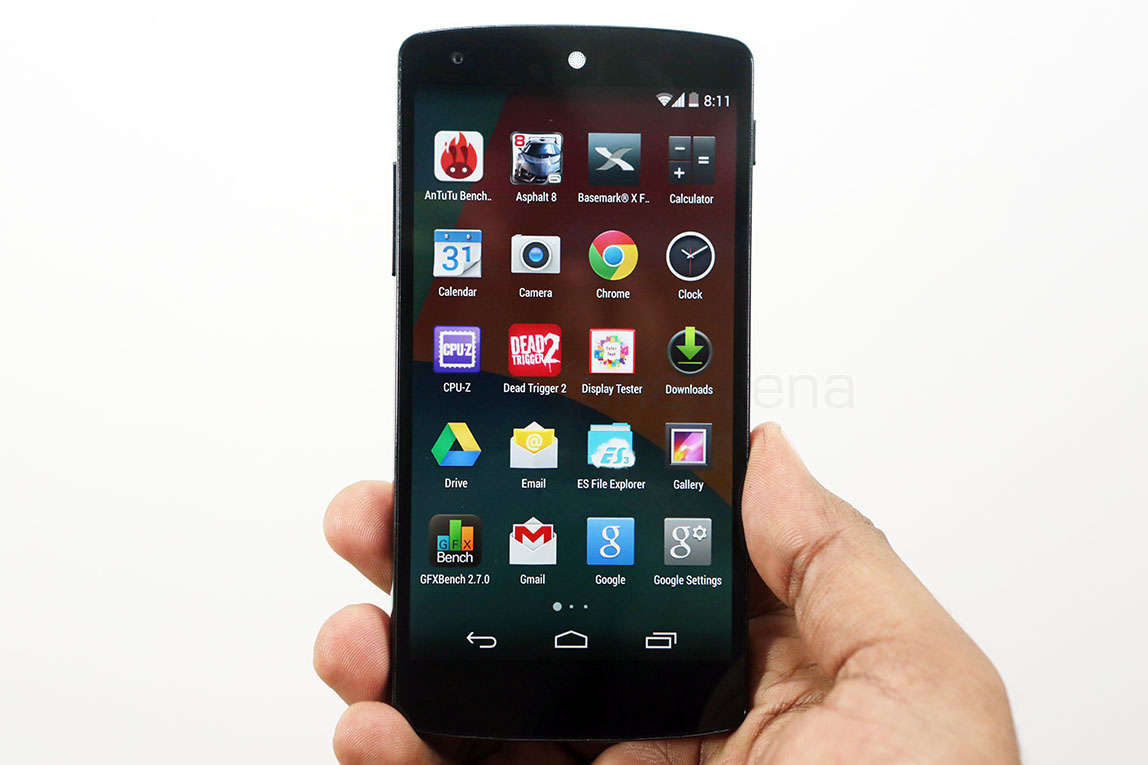
Honestly, all of the design changes are welcome, most notably the new launcher with in-built Google Now and the condensed Roboto Font. The tool tips are now more rounded and more modern, with the new white-based Holo light interface being used for all the default apps. It just makes the whole OS feel a lot more fresh and less Tron-like. But yeah, Hangouts SMS integration is still clunky, and of course the remnants of the old OS still exist, like for example the tron-holo blue UI pops up in some places, but that is inevitable, as this itself feels like a much larger change. We hope for more consistency in the future updates.
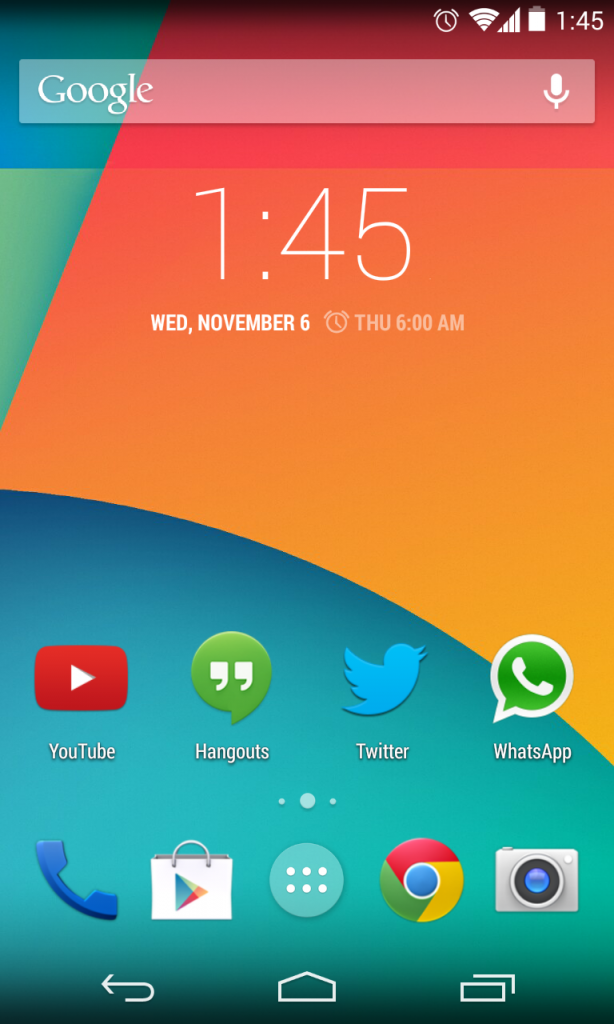
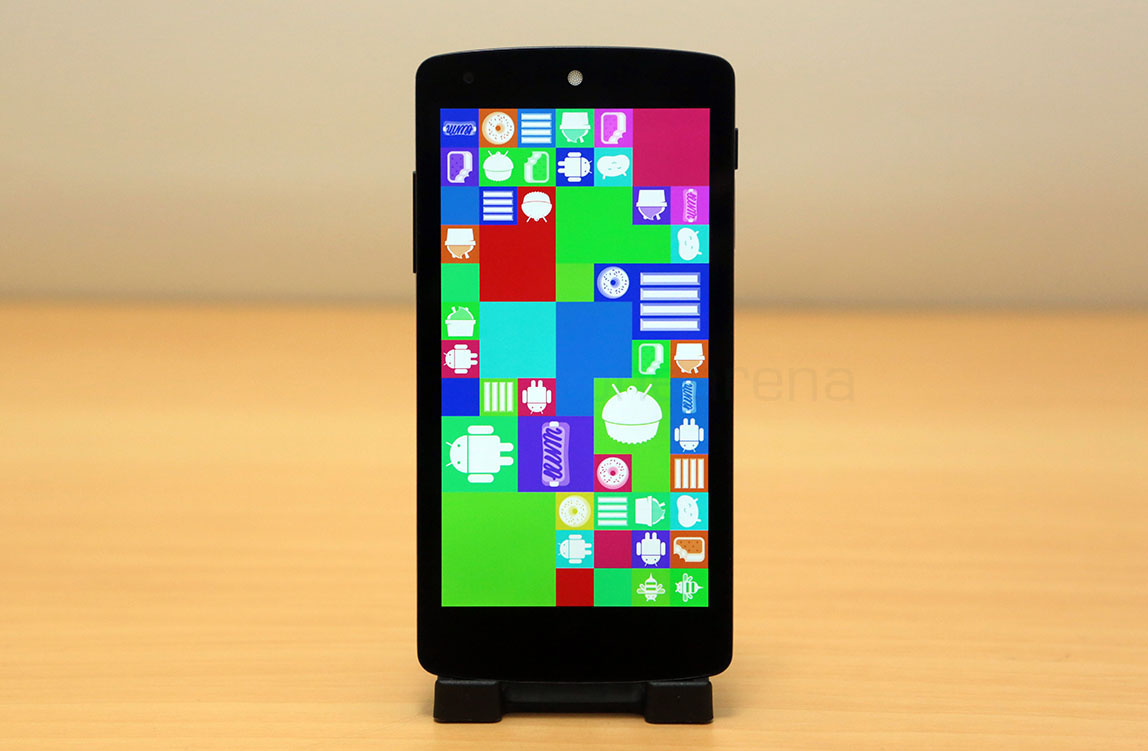
In the end, all these new features are just going to keep on coming to the Nexus 5, for 18 more months. Sadly, even if Android 4.4 brings support for devices with less RAM, the Galaxy nexus will not be getting the official update, but if you were planning to jump ship, then this might be right chance to get a Nexus 5, because the software is almost as if it’s tailored for this, and it shows.
Battery Life
The LG G2 has awesome battery life, so technically, with the Nexus 5 being its spiritual successor, the battery life should be similar right? Wrong. The 2300 mAH battery on the Nexus 5 is definitely not as good as the LG G2, or rather any other full HD smartphone with a high capacity battery but thank goodness, it is much better than the Nexus 4. I remember losing out about 20% of the battery on idle, overnight, only to wake up and be frustrated that I should charge the phone again. Thankfully, that is not the case with the Nexus 5 as it idles beautifully, with only losing utmost 2-4% overnight. This is a huge step forward from the Nexus 4, and we appreciate that, but that’s all it does. Otherwise, the battery life seems pretty average. First week, it was highly inconsistent, with it giving good and bad battery life on different days, but then it started stabilizing in the second, and now things are sailing smooth.
3 hours and 15 minutes – this is the average display time I usually get on the Nexus 5 on average use over WiFi+ occasionally 3G, but when you go full 3G or start using the device heavily, the battery drain is inevitable, mainly due to the bright display. No, auto-brightness won’t do you any good, the lethal combination of 3G plus display will drain the battery out in 6 hours of heavy usage, and that’s stretching it to a respectable number. So, overall a step up from the Nexus 4, but no where close to other devices in the same price range, in case you are expecting similar stellar performance.
Conclusion
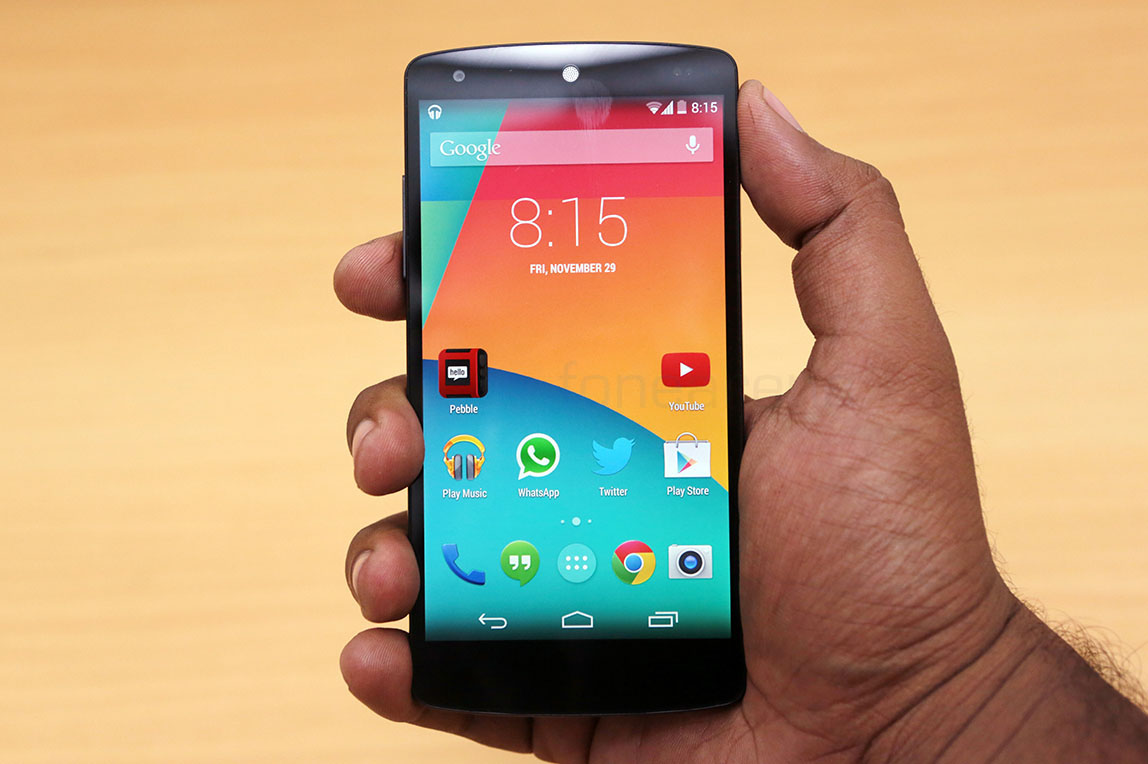
Google did buy Motorola for more than just patents, but commitment to the Nexus program has clearly not subsided. LG had tasted great success with the Nexus 4 and will mostly experience the same with the Nexus 5 too, especially since the planning of a global rollout has been immaculate so far. India, which never got the Nexus 4 on the Google Play Store, has got Nexus 5, that too within a month of the first launch schedule. Things have changed for the better, much like the Nexus 5. It improves upon its predecessor in every way, by having a better display, better build quality, faster processors and a better camera, and at the same time, being a Nexus device, with all the Google goodies non existent on other platforms, or even in its platform with other OEMS, may be not just yet. So, does that make Nexus 5 the best Google device ever made? Almost. It comes so close, save for the white variant’s build quality. There are also the usual disadvantages like an average battery, lack of micro SD expansion and the lack of a removable battery.
But at Rs. 28,999 for the 16GB version, the Google Nexus 5 is easily the ideal buy if you want the best device for instant Android updates and the purest Google experience. To Summarize, here is the list of pros and cons of the Nexus 5 -
Pros
- Good display
- Blazing fast performance
- Decent camera, in the HDR+mode
- Pricing
- Always the latest updates
Cons
- Build quality average in white variant
- No micro SD expansion
- Average battery life
- Loudspeaker is bad